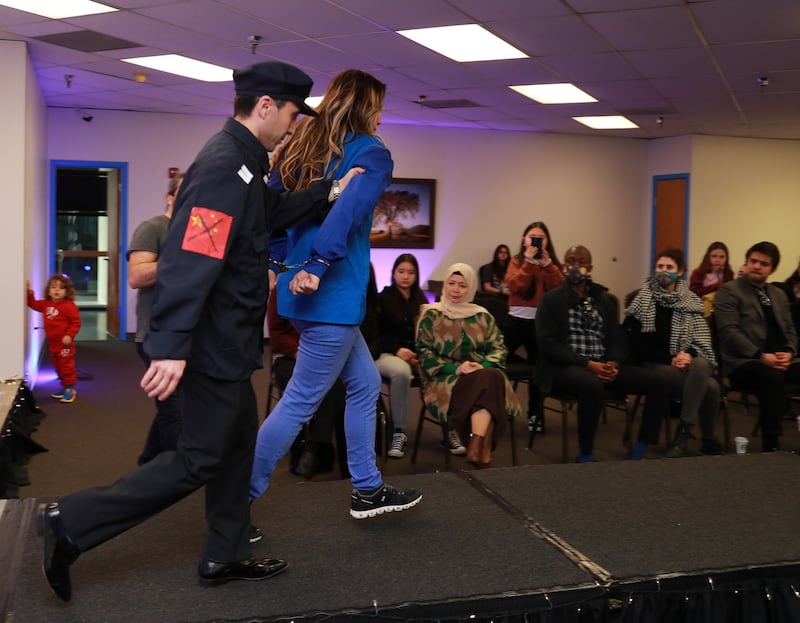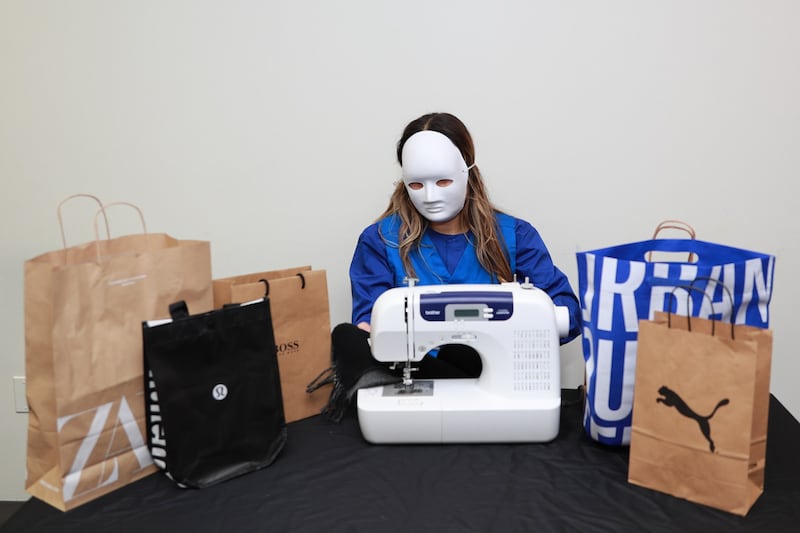The children wore traditional Uyghur clothing – etles silk dresses for the girls, white shirts with embroidered collars for the boys, doppa skullcaps for both – as they walked on a T-shaped stage. Parents and other spectators sat on chairs on either side, watching eagerly.
Photographers took pictures of a typical Uyghur display on the walls of the auditorium: a carpet depicting a Uyghur muqam musical performance, and a selection of traditional clothing and musical instruments.
The Uyghur American Association put on a “Uyghur Fashion Show” on Feb. 24 in Fairfax, Virginia, to celebrate their culture and highlight a trend that has gone unmentioned on the global runway: the use of Uyghur forced labor, which is deeply embedded in clothing supply chains.
“We organized this event to send a message to China: You can’t destroy our culture and you can’t destroy the hope and belief of our children in the future,” said Elfidar Iltebir, the association’s president. She hoped the event would both promote Uyghur culture and draw attention to clothing brands profiting from Uyghur forced labor.
The Uyghur region produces roughly 80% of China’s cotton – 20% of the global supply – along with an increasing amount of finished textiles and clothing.
Findings by the American government, NGOs, and journalists suggest that both raw material and finished consumer products have been made by Uyghurs and other ethnic minorities, under coercive conditions, as part of the Chinese government’s campaign of subjugation and control.

The U.S. Uyghur Forced Labor Prevention Act, which took effect in 2022, requires proof that no forced labor was involved in order to import goods made wholly or partially in Xinjiang. Genetic testing can determine whether the cotton in a finished product was grown in Xinjiang.
But many major brands do not disclose their sourcing. And researchers fear that among the brands actively complying with the law, some continue to do business in Xinjiang by bifurcating their supply chains and sending tainted products to the rest of the world.
“How can we stop the Chinese government’s exploitation of Uyghur forced labor? It’s a simple math problem,” said show attendee Jewher Ilham, Forced Labor Project Coordinator at the Workers’ Rights Consortium, a monitoring group.
Making it unprofitable for brands to use forced labor requires both government and individual action, she said. “We need to pass laws globally like the U.S.’s Uyghur Forced Labor Prevention Act. And, wherever possible, we need to stop buying from brands connected to Uyghur forced labor.”
‘I had to hold back my tears’
The Uyghur Fashion Show featured children’s clothing. The models were mainly Uyghur children, between the ages of 5 and 20 who were born and raised in the United States.
They wore family heirlooms, brought by their parents from the Uyghur region years ago: all colors and styles of etles dresses, embroidered doppa, fur tumaq caps. Some of the outfits were designed and sewn by Tursunay Ziyawudun, one of a handful of Uyghurs to have survived a Chinese internment camp and escaped abroad. Other outfits were brought from Uyghur clothing boutiques in Turkey and Uzbekistan.

In the first part of the show, the models walked the runway accompanied by Uyghur children’s music. They wore all styles of traditional Uyghur clothing, and held Uyghur musical instruments.
Then, there was a brief dramatic performance. In the skit, Chinese police stripped the doppa and etles coat from a Uyghur girl reading a book, and forcibly took her to a clothing factory. The sewing table in the factory was draped in bags from international brands.
“I had to hold back my tears, because this is reality – this kind of situation happens every day in the homeland,” said Elfidar Iltebir, the Uyghur American Association’s president, who played the role of the Uyghur girl.
‘Proud to be Uyghur’
After the performance, the children reappeared, carrying placards with slogans like “stop Uyghur forced labor,” and “clothing made with Uyghur forced labor isn’t fashionable”. The auditorium fell into silence.

One of the models participating in the show was Zilale, a young Uyghur-American. On stage, she wore a long etles dress designed by Tursunay Ziyawudun and held a dutar lute. In fluent Uyghur, she said that her mother had raised her with a Uyghur spirit. She expressed concern that mainstream Chinese culture was sanitizing and adopting Uyghur cultural symbols, even as the Chinese government punished Uyghurs for displaying them.
“We came here to say, no, this is Uyghur clothing, this is Uyghur culture,” she said. “I am so proud to be Uyghur.”
Translated by Nadir. Edited by Josh Lipes and Malcolm Foster.
